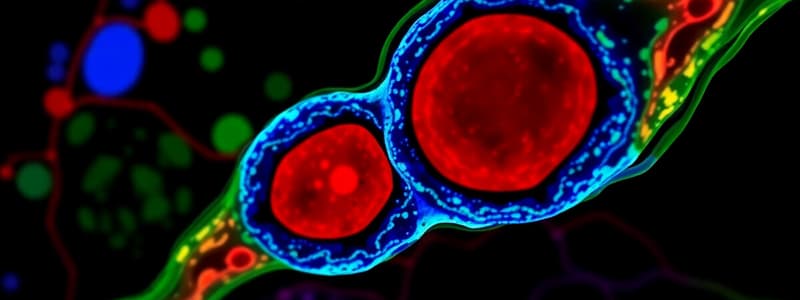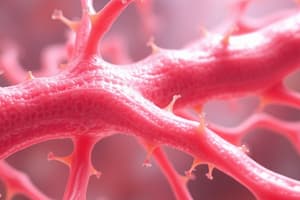Podcast
Questions and Answers
Which component provides the primary structural strength to a layer of epithelial cells?
Which component provides the primary structural strength to a layer of epithelial cells?
- Cell-cell junctions linked to the cytoskeleton (correct)
- The basal lamina
- Fibrous proteins secreted by fibroblasts
- The apical cell membrane
Anchoring junctions exclusively connect cells to the extracellular matrix (ECM).
Anchoring junctions exclusively connect cells to the extracellular matrix (ECM).
False (B)
What type of junction is primarily responsible for creating a selectively permeable barrier between epithelial cells?
What type of junction is primarily responsible for creating a selectively permeable barrier between epithelial cells?
Occluding junctions
__________ junctions facilitate the passage of signals between adjacent cells via direct cell-cell contact.
__________ junctions facilitate the passage of signals between adjacent cells via direct cell-cell contact.
Match the junction type with its primary function:
Match the junction type with its primary function:
What is the primary role of integrins as described?
What is the primary role of integrins as described?
Cadherins are found in all eukaryotic organisms, including fungi and plants.
Cadherins are found in all eukaryotic organisms, including fungi and plants.
What ion is essential for cadherin-mediated cell adhesion?
What ion is essential for cadherin-mediated cell adhesion?
The cadherin superfamily facilitates cell-cell adhesion in a manner dependent on the presence of ______ ions.
The cadherin superfamily facilitates cell-cell adhesion in a manner dependent on the presence of ______ ions.
Match each classical cadherin with the main tissue in which it was originally found:
Match each classical cadherin with the main tissue in which it was originally found:
Which type of junction is primarily responsible for preventing leakage between epithelial cells?
Which type of junction is primarily responsible for preventing leakage between epithelial cells?
Gap junctions are typically found on the apical side of the cell, above tight junctions.
Gap junctions are typically found on the apical side of the cell, above tight junctions.
What is the main function of channel-forming junctions like gap junctions?
What is the main function of channel-forming junctions like gap junctions?
In the Notch/Delta pathway, a membrane-bound ______ on one cell interacts with a membrane-bound receptor on another cell to transmit a signal.
In the Notch/Delta pathway, a membrane-bound ______ on one cell interacts with a membrane-bound receptor on another cell to transmit a signal.
Which cytoskeletal filaments are typically anchored between two cells at anchoring junctions?
Which cytoskeletal filaments are typically anchored between two cells at anchoring junctions?
Hemidesmosomes connect two cells to each other.
Hemidesmosomes connect two cells to each other.
What role do cadherins play in cell-cell adhesion?
What role do cadherins play in cell-cell adhesion?
Which of the following components primarily bear the mechanical stress in connective tissues like bone and tendon?
Which of the following components primarily bear the mechanical stress in connective tissues like bone and tendon?
Epithelial tissues primarily rely on the extracellular matrix for strength and bearing mechanical stress.
Epithelial tissues primarily rely on the extracellular matrix for strength and bearing mechanical stress.
What is the main function of FAK in the context of integrin connections?
What is the main function of FAK in the context of integrin connections?
The RGD domain is a key recognition sequence found on ______ that interacts with integrins.
The RGD domain is a key recognition sequence found on ______ that interacts with integrins.
Match the following terms with their description:
Match the following terms with their description:
Which of the following is an accurate description of how animal cells combine into strong, stable structures?
Which of the following is an accurate description of how animal cells combine into strong, stable structures?
Hemichannels are typically kept in an open conformation to facilitate constant communication between cells.
Hemichannels are typically kept in an open conformation to facilitate constant communication between cells.
What is the primary function of cell-cell junctions and cell adhesion?
What is the primary function of cell-cell junctions and cell adhesion?
Which of the following statements accurately describes the role of cadherins in cell adhesion and signaling?
Which of the following statements accurately describes the role of cadherins in cell adhesion and signaling?
E-cadherin is the only type of cadherin found on epithelial cells.
E-cadherin is the only type of cadherin found on epithelial cells.
Why is the shift in relative abundance of different cadherins important for cells?
Why is the shift in relative abundance of different cadherins important for cells?
Cadherins mediate ______ adhesion, meaning they bind to the same type of cadherin on another cell.
Cadherins mediate ______ adhesion, meaning they bind to the same type of cadherin on another cell.
What is the role of Calcium (Ca2+) in cadherin function?
What is the role of Calcium (Ca2+) in cadherin function?
What is the primary role of desmosome junctions in epithelial cells?
What is the primary role of desmosome junctions in epithelial cells?
Desmosomes create a belt-like structure across cells, similar to adherens junctions.
Desmosomes create a belt-like structure across cells, similar to adherens junctions.
In heart muscle cells, desmosomes attach to __________ filaments.
In heart muscle cells, desmosomes attach to __________ filaments.
Which type of cellular filament is linked to adherens junctions?
Which type of cellular filament is linked to adherens junctions?
How do cadherins facilitate cell-cell interactions?
How do cadherins facilitate cell-cell interactions?
What is the role of WNT signaling in the context of cadherins and cell junctions?
What is the role of WNT signaling in the context of cadherins and cell junctions?
Match the cell junction with its corresponding attached cytoskeletal filament:
Match the cell junction with its corresponding attached cytoskeletal filament:
Which of the following best describes the 'Velcro principle' in the context of cell junctions?
Which of the following best describes the 'Velcro principle' in the context of cell junctions?
Flashcards
Collagen
Collagen
A protein that provides structural support in tissues.
Elastin
Elastin
A protein that allows tissues to resume shape after stretching.
Integrins
Integrins
Proteins that facilitate cell-ECM adhesion and signal transduction.
RGD domain
RGD domain
Signup and view all the flashcards
FAK (Focal Adhesion Kinase)
FAK (Focal Adhesion Kinase)
Signup and view all the flashcards
Cell junctions
Cell junctions
Signup and view all the flashcards
Anchorage dependence
Anchorage dependence
Signup and view all the flashcards
Connective tissues
Connective tissues
Signup and view all the flashcards
Integrin superfamily
Integrin superfamily
Signup and view all the flashcards
Desmosomes
Desmosomes
Signup and view all the flashcards
Cadherins
Cadherins
Signup and view all the flashcards
E-cadherin
E-cadherin
Signup and view all the flashcards
Ca2+ ions
Ca2+ ions
Signup and view all the flashcards
Extracellular Matrix (ECM)
Extracellular Matrix (ECM)
Signup and view all the flashcards
Epithelial Cells
Epithelial Cells
Signup and view all the flashcards
Anchoring Junctions
Anchoring Junctions
Signup and view all the flashcards
Occluding Junctions
Occluding Junctions
Signup and view all the flashcards
Gap Junctions
Gap Junctions
Signup and view all the flashcards
Homophilic adhesion
Homophilic adhesion
Signup and view all the flashcards
Calcium dependence
Calcium dependence
Signup and view all the flashcards
Junction symmetry
Junction symmetry
Signup and view all the flashcards
Tight Junctions
Tight Junctions
Signup and view all the flashcards
Notch/Delta Pathway
Notch/Delta Pathway
Signup and view all the flashcards
Adherens Junctions
Adherens Junctions
Signup and view all the flashcards
Hemidesmosomes
Hemidesmosomes
Signup and view all the flashcards
Integrin Signaling
Integrin Signaling
Signup and view all the flashcards
β-catenin
β-catenin
Signup and view all the flashcards
Intermediate filaments
Intermediate filaments
Signup and view all the flashcards
Mechanical strength in epithelium
Mechanical strength in epithelium
Signup and view all the flashcards
WNT signaling
WNT signaling
Signup and view all the flashcards
Velcro principle
Velcro principle
Signup and view all the flashcards
Study Notes
Keywords from Lecture 7
- Collagen and elastin
- Fibronectin
- RGD domain
- Integrins
- Outside-in and inside-out signaling
- FAK
- Velcro Principle
- Anchorage dependence
Hemichannels
- Are hemichannels usually kept in the closed or open conformation?
- Many integrin connections (focal adhesions) need to be able to make and break.
- FAK is responsible for breaking them.
Lecture 8
- Cell junctions, cell adhesion, and the ECM
Cell Interactions
- Interactions between cells in multicellular organisms are fundamental.
- Cells connect to each other through cell-cell junctions or the ECM.
- Attachments to other cells and ECM control cell orientation.
- Defects in cell junctions, cell adhesion, and ECM underlie many diseases.
Cell Structure
- Small motile cells filled with aqueous medium and enclosed in plasma membrane.
- Two basic building strategies:
- Strength of the ECM
- Strength of the cytoskeleton within the cell along with cell-cell adhesions that link cytoskeletons of neighboring cells.
- Cytoskeleton of one cell is linked to the cytoskeleton of the neighboring cell which provides strength.
Animal Tissues
- Animal tissues are varied but can be classified into:
- Connective tissues (e.g., bone, tendon)
- Abundant ECM, sparse cells
- Matrix (rich in fibrous polymers like collagen) bears mechanical stress.
- Epithelial tissues (e.g., lining of gut, skin)
- Cells closely bound together into sheets.
- Scarce ECM, mainly a thin basal lamina.
- Cells linked via cell-cell adhesion; stress is dispersed this way.
- Connective tissues (e.g., bone, tendon)
Cell Junctions
- Physical attachment is crucial.
- Junctions between cell-cell or cell-matrix are structurally diverse.
- Four main functions can be distinguished, each on a molecular basis.
Types of Cell Junctions
- Anchoring junctions:
- Both cell-cell and cell-matrix adhesions
- Transmit stresses, linked to cytoskeletal filaments
- Occluding junctions:
- Seal gaps in epithelia, creating impermeable or selectively permeable barriers.
- Channel-forming junctions:
- Create passageways connecting adjacent cell cytoplasms.
- Signal-relaying junctions:
- Allow signal relay across plasma membranes at cell-cell contact sites.
Anchoring Junctions (Details)
- Anchor cells to each other and the ECM.
- Intermediate filaments, oriented toward the basal side, connect to basal lamina or other adjacent cells.
- Tight junctions: Located primarily at the apical surface of cells. Prevent leakage through the epithelial layer.
- Channel-forming junction (e.g., gap junctions): Found usually closer to the basal side of cells or beneath tight junctions. Allow transfer of small molecules like ions between cells.
- Signal relaying junctions (e.g., Notch/Delta pathway): Ligand on one cell interacts with a receptor on another cell, transmitting a signal to both cells.
Cadherins
- Cadherins mediate Ca2+-dependent cell-cell adhesion.
- Present in all multicellular animals but absent in fungi, plants, bacteria, and archaea.
- Their adhesive functions are complemented by signaling functions to relay information internally to the cell.
- Several types, named according to the tissue where they're found (E-cadherin, N-cadherin, P-cadherin).
- Their affinity for partners is relatively low but strength is high due to many weak bonds.
- Homophilic binding (like binds to like): This specificity is essential for tissue organization.
- Calcium (Ca2+) is critical to the binding of cadherins.
- Cell-cell adhesions are mediated by cadherins at junctions - these are called adherens junctions.
- Actin cytoskeleton linked between the two cells
Cell Segregation
- Cadherins are essential for cell sorting/segregation.
- Dissociated cells from different embryonic vertebrate organs (like liver, retina) will re-assemble into tissues of origin.
- Selective expression and regulation of different cadherins leads to different cell types
Cell-Cell Junctions (Summary)
- Critical for modeling the shapes of multicellular structures.
- Example: Adherens junctions form a continuous adhesion belt in epithelia.
- Junctions send signals, affecting cell differentiation (making large changes to their internal affairs).
- Complex crosstalk between adhesion machinery and chemical signaling pathways (e.g., β-catenin signaling, Wnt signaling).
- Desomosomes give epithelia mechanical strength. Structurally similar to adherens junctions but link to intermediate filaments (keratin in epithelial cells, desmin in heart muscle cells).
Studying That Suits You
Use AI to generate personalized quizzes and flashcards to suit your learning preferences.




